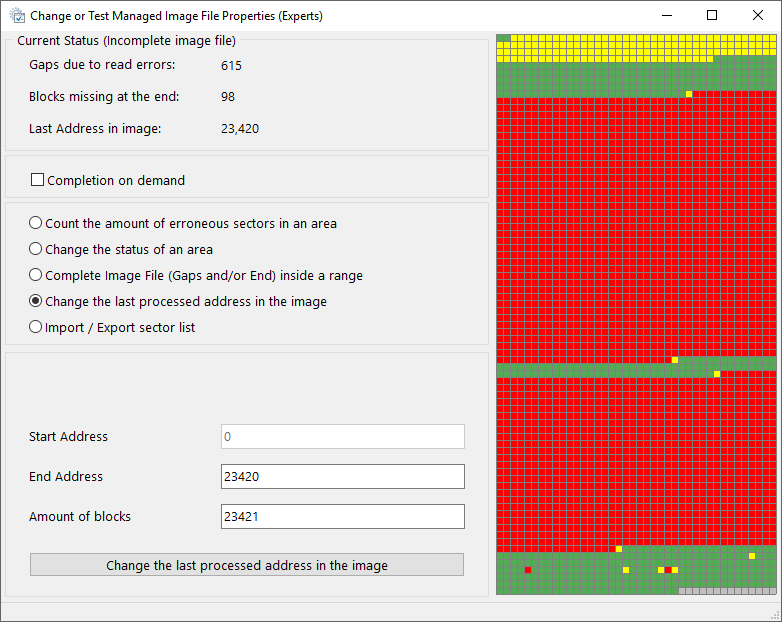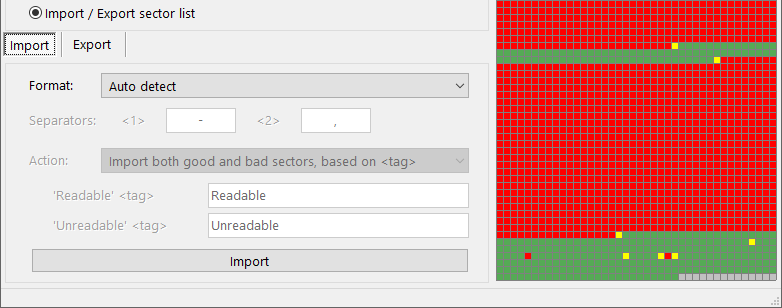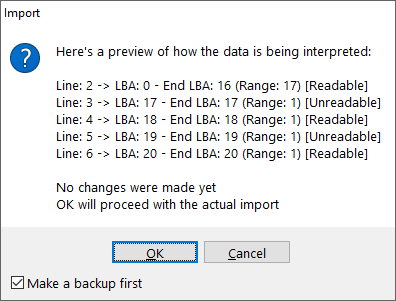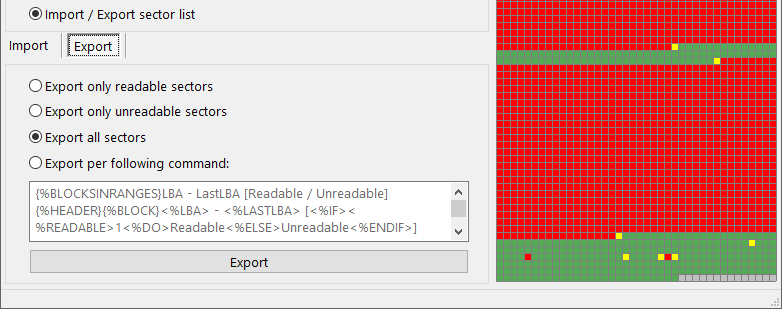Completare i cosidetti File Immagine gestibili

[Disponibile da IsoBuster 3.4 per le licenze [Professional] ]
Questo è principalmente per ingegneri ed esperti del recupero dati. Si possono caricare i file immagine gestiti IBP/IBQ e lavorare su questi.
Una volta cheil file immagine IBP/IBQ è stato caricato, fare clic destro del mouse sul combobox (il box dove si sceglie l'unità) e scegliere: "Cambiare o Testare le Proprietà File Immagine Gestito (Esperti)"
Ci sono tre opzioni che lavorano un intervallo dato
Calcolo dei settori errati in un'area
Specifica l'intervallo nel quale lavorare e rende il numero di errori rilevati in questo intervallo. Ad esempio conta i 'gap' in una zona che corrisponde ad un file.
Cambio dello stato di un'area
Permette di cambiare lo stato di 'leggibile' o 'illeggibile' di un blocco. Ad esempio, se si imposta un settore corretto (già letto correttamente) come non leggibile, si crea un 'gap' per quei settori, che saranno riletti quando si lancerà un 'Completa Immagine: riempi i gap'. Se queste riletture dovessero fallire, i dati validi non sono rimpiazzati da zeri e la lettura precedente resta intatta. Se la lettura ha successo, i dati sono sovrascritti dai nuovi dati letti. Si possono anche impostare come leggibili dei settori errati, il che significa che non saranno più riletti (almeno finché non vengono impostati di nuovo come illeggibili). Si può impostare una regione come leggibile o illeggibile, al di là che sia già stata letta, in modo da completare l'immagine fino alla fine, ed essenzialmente saltare una intera regione. Gli ingegneri creativi possono scoprire tanti modi di usare questa funzione. Quando l'intervallo eccede ciò che è già stato letto, IsoBuster completa l'immagine alla fine ma usa un meccanismo di lettura fittizio. Non viene fatta alcuna lettura, i settori sono riempiti di zero, indipendentemente dal fatto che siano impostati come 'leggibili' o 'illeggibili'. Tanto potere porta grande responsabilità: da usare con attenzione.
Completa File Immagine (Gaps e/o End) entro un intervallo
Completa l'immagine, riempiendo i gap e leggendo fino alla fine, ma entro i limiti fissati.
Change the last processed address in the image
When you create a managed image file, IsoBuster keeps track of readable and unreadable blocks. When you stop the process at a given time, you can always load the *.ibp image again and complete it.
The point where you stopped making the image file is the 'last processed address' (LPA for the sake of this paragraph). In the visual blocks map on the right, all blocks beyond the LPA are colored grey (status unknown). When you complete a managed image file, unreadable blocks before the LPA are read one block at a time, as part of the 'filling gaps 'process. All blocks passed LPA are read normally, x blocks at a time, because their status is still unknown. In case of perfectly readable media, the latter is much faster than 'filling gaps' one block at a time. For engineering purposes it sometimes makes sense to move the LPA to a lower address again, for instance if a hardware problem was resolved, to read the part beyond the LPA normally again (and hence much faster).
Import address ranges into the sector status bitmap

[Available since IsoBuster 4.4 for people with a [Professional] license]
IsoBuster supports the import of text files (also *.csv files) with addresses (and a status: readable or unreadable) into the sector status bitmap.
This way you can influence what data is already read and what data still needs to be (re)read.
It does the same as previously explained option "Change the status of an area" but based on a list of imported data.
It facilitates the exchange of data between different applications as well.
You might need to tweak the import file a bit for it to be supported properly but a non intrusive test-run will always first show you how the file is being interpreted. Also, a backup of the *.IBP file is made before import, so you can safely experiment.

It might also be wise to do an Export first (see below) to both have an example template and a backup of current situation (that can be imported again at a later moment).
There are three supported ways to import:
- Automatic detection, where IsoBuster tries to understand the format and imports it the way it sees fit. This works pretty well and certainly supports the standard export ways IsoBuster supports.
- LBA <1> Last LBA <2> <tag> For instance "0 - 1000 readable" where 0 is the start address, 1000 is the last address (so a total of 1001 blocks), seperator <1> is '- ' and seperator <2> is ' ' and the tag is 'readable'
- LBA <1> Range (Blocks) <2> <tag> For instance "0 - 1000 unreadable" where 0 is the start address, 1000 is the range (so a total of 1000 blocks), seperator <1> is '- ' and seperator <2> is ' ' and the tag is 'unreadable'
Use the seperator and tag fields in the GUI to put your own text in, relevant to your import text file.
For instance if the line reads: "0,1000,error" you will need to put a comma in the two seperator fields and write error in the 'Unreadable tag' field.
Additionally:
The seperator fields also accept <%TAB> which is replaced with a tab character
The tag fields also accept one or more of these special tags:
<%CI> which means the tag compare test is done case insensitive.
<%WC> which means the tag compare test accepts wild cards
<%RE> which means the tag compare test accepts regular expressions
Export status bitmap address ranges into a text file

[Available since IsoBuster 4.4 for people with a [Professional] license]
IsoBuster supports the export of text files. There are 4 supported methods.
Create a list of only readable sectors. The template used is the one in the edit box below it.
Create a list of only unreadable sectors. The template used is the one in the edit box below it.
Create a list of all sectors but mark which ones are readable and which ones are not. The template used is the one in the edit box below it.
Create a list of sectors based entirely on your own template which you can define in the edit box below it.
The template syntax is completely based the /tree command line parameters
Also see: Creare e completare un file immagine gestitio